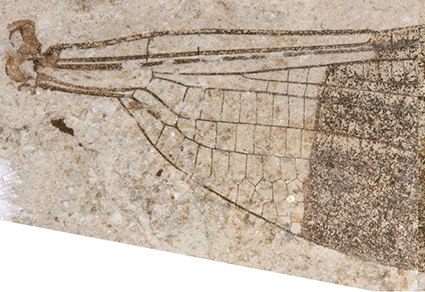Abstract
We propose Danowhetaksa n. gen. (Odonata: Whetwhetaksidae) with two new species: D. birgitteae n. gen. et sp. and D. rusti n. gen. et sp. from the earliest Ypresian Stolleklint clay of the Ølst Formation in northwestern Denmark. Whetwhetaksidae has previously been known only from the Ypresian Okanagan Highlands of far-western North America, the new records are, therefore, the first from the Palearctic Region.
References
Archibald, S.B., Cannings, R.A., Erickson, R.J., Bybee, S.M. & Mathewes, R.W. (2021) The Cephalozygoptera, a new, extinct suborder of Odonata with new taxa from the early Eocene Okanagan Highlands, western North America. Zootaxa, 4934(1), 1–133. https://doi.org/10.11646/zootaxa.4934.1.1
Archibald, S.B. & Makarkin, V.N. (2006) Tertiary Giant Lacewings (Neuroptera: Polystoechotidae) revision and description of new taxa from western North America and Denmark. Journal of Systematic Paleontology, 4, 119–155, 307 (errata). https://doi.org/10.1017/S1477201906001817
Bechly, G. (1996) Morphologische Untersuchungen am Flügelge der der rezenten Libellen und deren Stammgruppenvertreter (Insecta; Pterygota; Odonata) unter besonderer Berüchsichtigung der Phylogenetischen Systematik und des Grundplanes der Odonata. Petalura, B blingen, Special Volume, 2, 1–402.
Bechly, G. & Rasmussen, J.A. (2019) A new genus of hawker dragonfly (Odonata: Anisoptera: Aeshnidae) from the Early Eocene Fur Formation of Denmark. Zootaxa, 4550 (1), 123–128. https://doi.org/10.11646/zootaxa.4550.1.6
Bøggild, O.B. (1918) Den vulkanske Aske i Moleret samt en Oversigt over Danmarks ældre Tertiærbjergarter. Særtryk af Danmarks Geologiske Undersøgelse, 2, 33. https://doi.org/10.34194/raekke2.v33.6819
Dunkley Jones, T., Lunt, D.J., Schmidt, D.N., Ridgwell, A., Sluijs, A., Valdes, P.J. & Maslin, M. (2013) Climate model and proxy data constraints on ocean warming across the Paleocene–Eocene Thermal Maximum. Earth-Science Review, 125, 123–145. https://doi.org/10.1016/j.earscirev.2013.07.004
Fabricius, J.C. (1793) Entomologica systemica emendata et acuta, Secundum classes, ordines, genera, species, adjectis synonymis, locis, observationibus, descriptionibus. C.G. Proft, Hafniae, 519 pp. https://doi.org/10.5962/bhl.title.125869
Garrison, R.W., von Ellenrieder, N. & Louton, J.A. (2010) Damselfly genera of the New World: an illustrated and annotated key to the Zygoptera. Johns Hopkins University Press, Baltimore, Maryland, 490 pp.
Garrouste, R. & Nel, A. (2015) New Eocene damselflies and the first Cenozoic damseldragonfly of the isophlebiopteran lineage (Insecta: Odonata). Zootaxa, 4028 (3), 354–366. https://doi.org/10.11646/zootaxa.4028.3.2
Heie, O. (1993) Insects from the Fur Formation in Denmark (Mo-clay, Upper Paleocene—Lower Eocene?). 8. Aphidoidea (Homoptera). Meyniana, 45, 57–64. https://doi.org/10.1127/njgpm/1993/1993/239
Heilmann-Clausen, C. (1995) Palæogene aflejringer over Danskekalken. In: Nielsen, O.B. (Ed.), Danmarks geologi fra Kridt til i dag. Aarhus Geokompendier. 1. Geologisk Institut, Aarhus Universitet, Aarhus, pp. 69–114.
Henriksen, K.L. (1922) Eocene insects of Denmark. Danmarks Geologiske Undersøgelse, 2 (37), 1–36. https://doi.org/10.34194/raekke2.v37.6823
Jones, M.T., Percival, L.M.E., Stokke, E.W., Frieling, J., Mather, T.A., Riber, L., Schubert, B.A., Schultz, B., Tegner, C., Planke, S. & Svensen, H.H. (2019) Mercury anomalies across the Palaeocene-Eocene Thermal Maximum. Climate of the Past, 15, 217–236. https://doi.org/10.5194/cp-15-217-2019
Larsen, L.M, Fitton, J.G. & Pedersen, A.K. (2003) Paleogene volcanic ash layers in the Danish Basin: composition and source areas in the North Atlantic Igneous Province. Lithos, 71, 47–80. https://doi.org/10.1016/j.lithos.2003.07.001
Larsson, S.G. (1975) Palaeobiology and the mode of burial of the insects of the lower Mo-clay of Denmark. Bulletin of the Geological Society of Denmark, 24, 193–209.
Madsen, H.O.R. & Nel, A. (1997) Two new fossil species of Gomphaeschna Selys, 1871 in the Paleocene / Eocene of Denmark (Odonata: Aeshnoidea). Annales de la Société Entomologique de France, New Series, 33, 285–293.
Madsen, H. & Rasmussen, J.A. (2021) Geologien fortæller: Moler og Fossiler / What geology tells: The mo-clay and its fossils. Museum Mors, 103 pp. ISBN 87-87566-91-5.
McInerney, F.A. & Wing, S.L. (2011) The Paleocene-Eocene Thermal Maximum: A Perturbation of Carbon Cycle, Climate, and Biosphere with Implications for the Future. Annual Review of Earth and Planetary Sciences, 39, 489–516. https://doi.org/10.1146/annurev-earth-040610-133431
Pedersen, G.K., Pedersen, S.A.S., Bonde, N., Heilmann-Clausen, C., Larsen, L.M., Lindow, B., Madsen, H., Pedersen, A.K., Rust, J., Schultz, P.B., Storey, M. & Willumsen, P. S. (2012) Molerområdets geologi—sedimenter, fossiler, askelag og glacialtektonik. Geologisk Tidsskrift, 2011, 41–135.
Petrulevičius, J.F., Nel, A., Rust, J., Bechly, G. & Kohls, D. (2007) New Paleogene Epallagidae (Insecta: Odonata) recorded in North America and Europe. Biogeographic implications. Alavesia, 1, 15–25.
Petrulevičius, J.F., Wappler, T., Wedmann, S., Rust, J. & Nel, A. (2008) New megapodagrionid damselflies (Odonata: Zygoptera) from the Paleogene of Europe. Journal of Paleontology, 82, 1173–1181. https://doi.org/10.1666/07-091.1
Rasmussen, J.A., Madsen, H., Schultz, B.P., Sylvestersen, R.L. & Bonde, N. (2016) The lowermost Eocene deposits and biota of the western Limfjord region, Denmark—Field Trip Guidebook. 2nd International Mo-clay Meeting, 2–4 November 2016. Muserum, Skive and the Fossil and Mo-clay Museum, Museum Mors, Nykøbing Mors, 38 pp.
Rehn, A.C. (2003) Phylogenetic analysis of higher-level relationships of Odonata. Systematic Entomology, 28, 181–239. https://doi.org/10.1046/j.1365-3113.2003.00210.x
Riek, E.F. & Kukalová-Peck, J. (1984) A new interpretation of dragonfly wing venation based upon Early Upper Carboniferous fossils from Argentina (Insecta: Odonatoidea) and basic character states in pterygote wings. Canadian Journal of Zoology, 62, 1150–1166. https://doi.org/10.1139/z84-166
Rust, J. (1999) Biologie der Insekten aus dem ältesten Tertiär Nordeuropas. Habilitationsschrift, Georg-August-Universität, Göttingen, 482 pp., 34 pls.
Rust, J. (1998) Fossil insects from the Fur and Ølst formations (“mo-clay”) of Denmark (upper Palaeocene/lowest Eocene). Proceedings of the first international Palaeoentomological Conference, Moscow, 1998, 135–139.
Rust, J. & Ansorge, J. (1996) Bemerkentswerde Moler-Insekten. Fossilen, 6/96, 359–364.
Rust, J., Petrulevičius, J.F. & Nel, A. (2008) The first damselflies from the lowermost Eocene of Denmark, with a description of a new subfamily (Odonata, Zygoptera, Dysagrionidae). Palaeontology, 51, 709–713. https://doi.org/10.1111/j.1475-4983.2008.00780.x
Stokke, E.W., Jones, M.T., Tierney, J.E., Svensen, H.H. & Whiteside, J.H. (2020) Temperature changes across the Paleocene-Eocene Thermal Maximum—a new high-resolution TEX86 temperature record from the Eastern North Sea Basin. Earth and Planetary Science Letters, 544, 116388. https://doi.org/10.1016/j.epsl.2020.116388
Westerhold, T., Marwan, N., Drury, A.J., Liebrand, D., Agnini, C., Anagnostou, E., Barnet, J.S.K., Bohaty, S.M., De Vleeschouwer, D., Florindo, F., Frederichs, T., Hodell, D.A., Holbourn, A.E., Kroon, D., Lauretano, V., Littler, K., Lourens, L.J., Lyle, M., Pälike, H., Röhl, U., Tian, J., Wilkens, R.H., Wilson, P.A. & Zachos, J.C. (2020) An astronomically dated record of Earth’s climate and its predictability over the last 66 Million Years. Science, 369, 1383–1387. https://doi.org/10.1126/science.aba6853
Zessin, W. (2011) Neue Insecten aus dem Moler (Paläozän/Eozän) von Dänemark Teil 1 (Odonata: Epallagidae, Megapadagrioniidae). Virgo, 14, 64–73.


